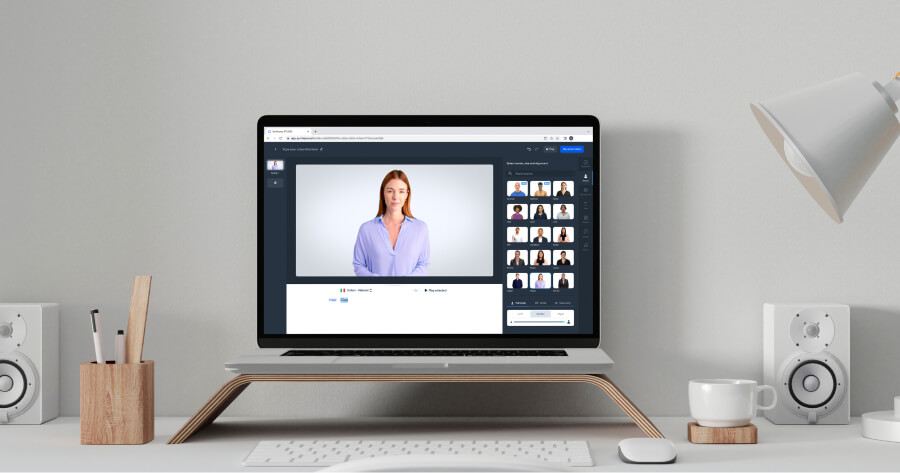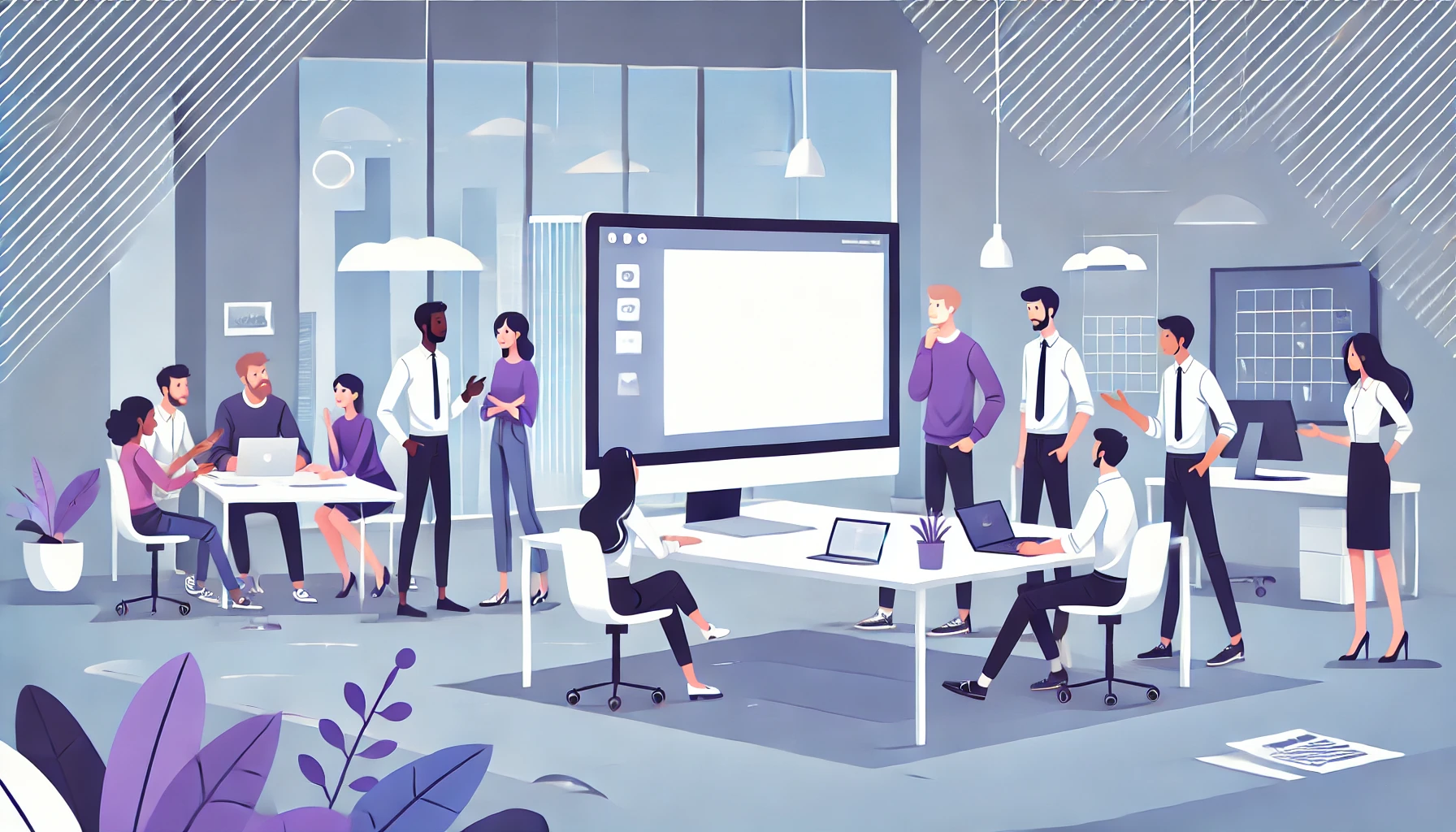
Create AI videos with 230+ avatars in 140+ languages.
Consumer behaviors continually evolve. Sellers must adapt their sales enablement strategies to maintain a competitive advantage, gain customer loyalty, and keep hitting or exceeding their sales quota expectations.
Being aware of change is the first step to preparing high-performing sales teams. This blog post gives you insights into 6 of the latest sales enablement trends. Watch out for these; they'll shake the sales enablement industry and shape sales processes in 2024 and beyond.
Read on to learn what sales enablement trends will help you meet today's market demands and anticipate tomorrow's needs.
Trend 1: AI sales enablement videos significantly improve results
AI is becoming integral in sales activities. 68% of business leaders already consider AI tools useful to their business strategy. These leaders expect that, by 2024, most sales enablement software will have built-in AI.
But of all the AI-powered sales enablement content types, videos are the most effective, whether for internal or external use. AI sales enablement videos help you better train your customer-facing employees, persuade potential buyers, and sell more (all while spending significantly less on video production.)
When a company called Cohesity started creating AI videos for its customers and business partners, its view retention increased by 200%. The company also saved $100,000 on video production. Talk about AI helping you make engaging videos easily, save money, and boost sales.
How you can use this trend:
- Create AI sales enablement videos: Experiment with AI video makers like Synthesia. Create video sales enablement solutions to introduce new products, teach sales techniques, or provide market insights or role-playing scenarios.
- Customize for impact: Your AI-generated videos should address specific customer pain points or frequently asked questions. Personalized content can boost engagement and conversion rates.
- Train smarter, not harder: Onboard new reps or teach your sales teams about new products with engaging AI videos. They're scalable, so you can train anyone, anytime, and keep everyone on the same page. Check out this library of sales enablement videos you can replicate and customize for your own business.
- Reduce costs: Ditch traditional video production and use your AI video tool to create new content, update content more often, and expand your training library. Redirect your savings toward other awesome sales tools or sales training programs.
- Learn as you go: The beauty of AI videos is that they track how people interact with them. Use this data to see what's working and what's not so you can refine your sales strategy and make future videos even better.
- Scale your sales enablement content: Put your content creation on steroids and use AI to pump out a ton of fresh videos. This way, you'll always have a steady stream of video content to support your training, product launches, and marketing efforts all year round. No more scrambling at the last minute.
Trend 2: Interest in sales enablement resources is on the rise
Sales enablement statistics show that employers and employees are beginning to pay more attention to this topic. On Google alone, the search volume for "sales enablement" increases by over 51% yearly. Look at sales enablement statistics for companies, and you'll see that adoption has increased by 343% over the last 5 years.
The world of sales is getting smarter and more supportive, and businesses are aiming for sales enablement maturity. As the search for "sales enablement" skyrockets and companies jump on board, it's clear that providing sales reps with the tools and training they need is a top priority.
How you can use this trend:
- Become a sales enablement champion: Sales leaders and execs love numbers. Be the sales rep who shows them the skyrocketing adoption rates and the potential to crush sales goals with proper tools and training.
- Boost your online visibility: People are searching for sales enablement information online. Help your company stand out by creating awesome content, such as blog posts, white papers, and even case studies, that showcase your sales enablement expertise. This will position your company as a leader and attract top talent that will improve your sales performance even more.
- Sharpen skills and sales operations: Make sales reps follow regularly updated training that keeps them on top of the latest sales strategies and technologies. Bonus points: Suggest incorporating fun, interactive elements to keep things engaging.
- Make data your BFF: Data doesn't lie. Push for tools that track the performance of your sales calls and meetings and measure the engagement of your sales team. Then, use this intel to create laser-focused training programs and tweak your sales strategies for maximum impact.
- Invest in your tech stack: With all this buzz, now's the perfect time to advocate for advanced sales enablement platforms — it doesn't have to be HubSpot's Sales Hub or Salesforce's Sales Cloud; you can also look into Seismic, Highspot, or Showpad. Also, look for tools that play nicely with your other business apps and boost the overall efficiency of your sales teams.
Trend 3: Enablement teams are growing
Sales enablement is becoming more of a necessity than just a hot trend. After years of layoffs, companies recognize its importance and actively build teams of sales enablement pros.
On LinkedIn, "sales enablement specialist" was the 6th fastest-growing job title in 2023. And guess what? 87% of top cloud companies already have revenue enablement professionals on board, with teams typically rocking around four members.
In short, the future of sales is about investing in sales enablement teams and giving sales reps the tools and training they need to win.
How you can use this trend:
- Push for specialized roles: Highlight the benefits of specialized enablement roles and advocate for their creation within your sales team.
- Take advantage of your team's expertise: Your enablement team is a brain trust. Use their diverse skills to craft tailored training, content, and strategies for specific sales cycle stages and address buyer needs directly.
- Show where the money is coming from: Regularly track and report the impact of your sales enablement efforts on sales outcomes. Use facts and figures to show how these strategies reduce onboarding time and improve key sales metrics. This data will solidify your team's value.
- Expand enablement resources: Even if you have a sales enablement team already, advocate for growing it. A scalable enablement team is key to sustained success.
- Make dream work with teamwork: Sales don't happen in a silo. Encourage collaboration between marketing and sales departments, and even product development. When sales and marketing work together, companies have more comprehensive sales strategies aligned with overall business goals, and sales reps achieve better results.
Trend 4: Sales reps and leaders want more enablement resources
The days of a salesperson winging it with charm and a Rolodex are long gone. Today's sales reps will demand the tools and training they need to succeed. Companies are listening, so 84% of sales reps close the forecasted deals and achieve their quotas when their employer incorporates an effective sales enablement strategy.
Nearly 80% of sales professionals say sales enablement content is important to making a sale. And they're not just talking about fluffy brochures anymore. Effective sales enablement content can take many forms, from targeted presentations and battle cards to data-driven insights and competitor comparisons.
The key is providing sales reps with all the tools and resources to have insightful conversations with potential customers and close more sales. That's why sales enablement statistics indicate that companies with sales enablement strategies typically register an 8% increase in quarterly revenue.
How you can use this trend:
- Embed enablement into your sales DNA: Make the sales enablement function a core part of your sales process, integrating training and resources seamlessly into your daily routine. Empowered salespeople are happy salespeople, and happy salespeople hit their revenue targets.
- Create content that helps close more deals: Focus on creating high-quality, relevant sales enablement resources that your sales teams can easily access and use for a more effective sales pitch — product sell sheets, sales scripts, playbooks, battlecards, infographics, case studies, and even lead magnets (Taskade is a great tool for generating lead magnets with AI).
- Keep an eye on your sales tools: Don't just throw tools at your sales team and hope for the best. Continuously evaluate your sales enablement tools and get feedback from your sales hires. Are they helpful? Are they user-friendly? Refine your tech stack to keep it relevant and effective.
- Use data to keep crushing quotas: Use analytics to see what types of content and tools are getting you results. Adjust your enablement strategies based on what's working, and you'll see higher usage and a more impactful sales force. Also, showcase the ROI of your tools to secure continued support and investment from the top.
Trend 5: Sales enablement teams are increasing their automation skills
Thomas Cheriyan, Director of Revenue Enablement at Rattle, says the sales enablement game has changed: "It's not enough to have data; it's about making that data work for us, tirelessly, behind the scenes [...] As we plunge headfirst into 2024, the message is clear: Embrace data automation in sales enablement or get left behind."
Sure enough, sales professionals are drowning in data and repetitive tasks, but automation is coming to the rescue. Studies show that in companies that use CRM and marketing automation along with AI, sales professionals save a whopping ~two hours and seven minutes daily on prospect outreach and ~two hours and 15 minutes daily on repetitive tasks. That's almost five hours a day your sales reps spend on tasks they could skip and focus instead on higher-value activities.
New technologies like generative AI power sales automation. GenAI's top uses among sales professionals are automating manual tasks (35%), extracting data-driven insights (34%), and generating prospect outreach messages (31%).
How you can use this trend:
- Free up sales reps from routine tasks: Implement AI tools to automate repetitive tasks like data entry, scheduling meetings, and even taking notes. Check out Calendly for intelligent scheduling, Outreach for automated sales sequences, or Hunter.io to find email addresses in seconds.
- Unlock the power of data: Data is gold, but only if you can understand it. Use AI tools to automate and continuously analyze your prospecting and sales data. Look into Apollo.io to scour through data on 275M contacts and 65M accounts, Salesforce Einstein for predictive scoring, Forwrd.ai for lead scoring based on user behavior, Clari for pipeline management and revenue forecasting, and Zoho CRM or RELEX for AI-powered sales forecasting.
- Personalize at scale: Personalized outreach messages can be time-consuming, but they're crucial. Use generative AI to create these messages fast. You've got Synthesia for custom, scalable AI videos, Adobe Marketo for dynamic content personalization, and Outreach for AI-driven sales engagement.
- Integrate systems for efficiency: Integrate all your tools into one central hub or sales enablement platform to allow for seamless data flow between platforms. This reduces the likelihood of errors and makes managing customer relationships a breeze.
Trend 6: Sales enablement resources help reps get personal
Customers crave your brand, not just your product, and want to feel like you know each other well. Over 70% of customers expect personalized experiences, and 71% get frustrated with generic interactions.
That's a wake-up call for sales and marketing alignment. Sales teams must create experiences that resonate with individual customer needs. Luckily, AI and automation tools will allow sales enablement pros to create hyper-personalized customer experiences with detailed buyer personas, customer journey maps, accurate audience segmentation, targeted messaging, and careful content curation.
An example of the mind-blowing personalization AI can favor is the Messi Messages video experience. It enables fans to send personalized videos with the famous football player Lionel Messi addressing their friends by name and speaking multiple different languages:
How you can use this trend:
- Make an impact with AI videos: Take free trials or demos of software like Synthesia and see what it's like to edit your videos in seconds. Experiment with the different options to change the script, translate or localize the content, and even swap diverse AI avatars (presenters). Your sales and marketing teams can greatly benefit from such videos.
- Develop detailed buyer personas: Craft detailed profiles to understand your ideal customer's needs. Think of them as portraits that help you speak their language. If you have an email list, check out RightMessage for email list segmentation and personalization.
- Map the customer journey: Use customer journey maps to visualize the different stages your customers go through in the sales funnel. This way, you'll create more targeted engagements at each stage and say the right things at the right time. Adobe Experience Platform is particularly powerful and packed with AI and ML capabilities.
- Play it smart with audience segmentation: Use AI and data analytics to segment audiences more precisely based on behavior, demographics, and purchase history. Look into Hubspot's Marketing Hub or IBM Watson Marketing for this purpose.
- Curate content carefully: Valuable content builds trust and conversions. Find content that addresses the specific interests and needs of different segments and make it part of your marketing strategy. When you're intentional and share relevant content, you create stronger connections with your customers.
Enable your reps to sell more with AI videos
AI video creation gives you the most powerful efficiency and personalization capabilities for sales processes and customer success. You can use it to train your new sales reps, create the best sales onboarding programs for new customers, upsell or cross-sell existing customers, and even enter new markets.
But before you can benefit from all these, take the first and most important step for your sales enablement strategy: create AI sales training videos your reps won't skip!
About the author
Learning Strategist & Speaker
Elly Henriksen
Elly Henriksen is a accomplished instructional designer exploring the impact of AI-generated content on learning design. With eight years of experience across both professional and higher education institutions, notably The University of Washington, Elly provides an insightful perspective on the transformative power of synthetic media for learners and instructional designer. Her versatile roles, from course facilitator to eLearning author and LMS administrator, give her a unique vantage point on the evolving trends in instructional design and how AI impacts the learning landscape. Explore Elly's insights and her pursuit of leveraging AI to redefine the future of the learning world.
















